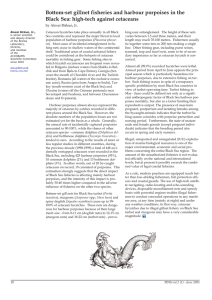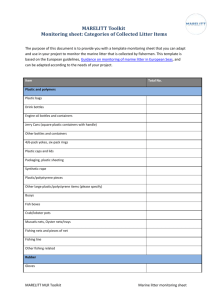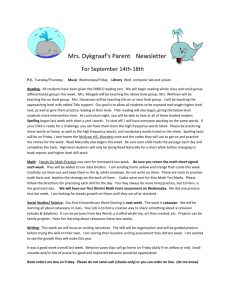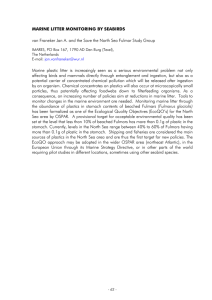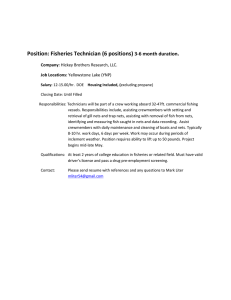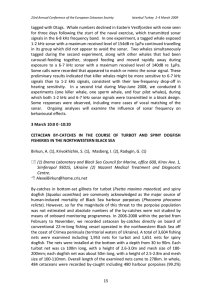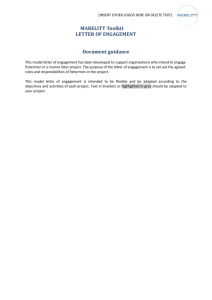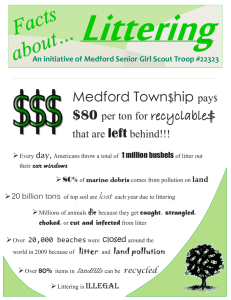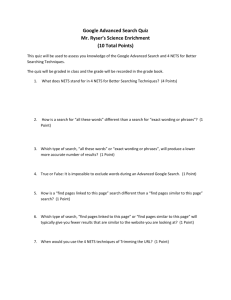Fi s n Vol. 4, N. 2, 2009 page 17
advertisement
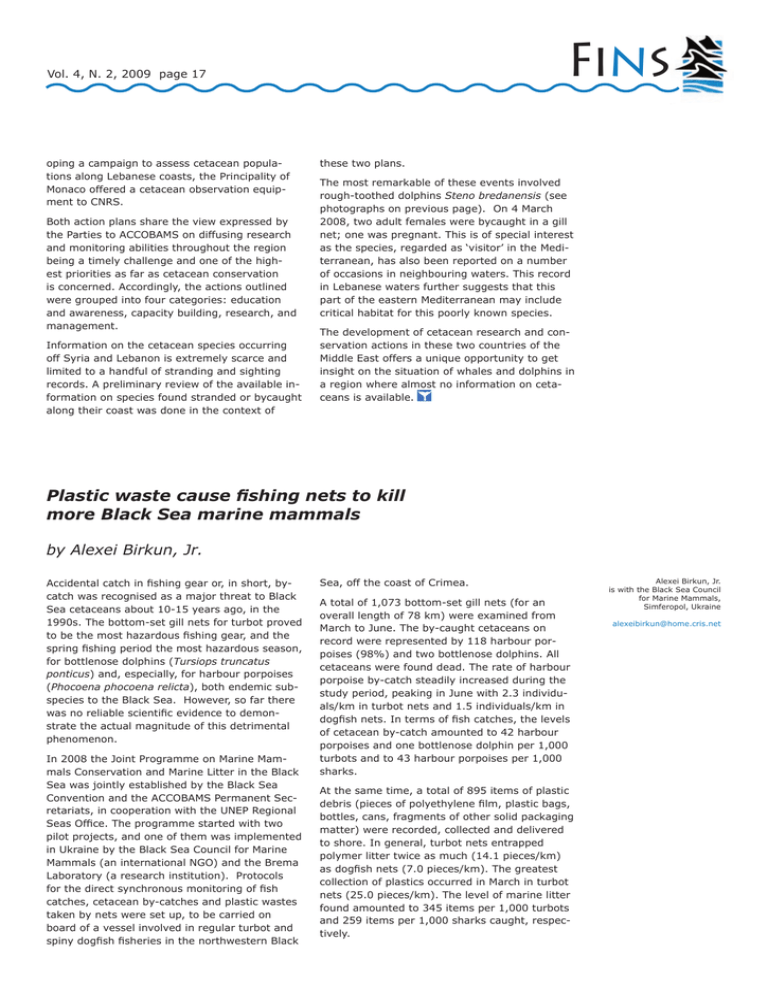
Fins Vol. 4, N. 2, 2009 page 17 oping a campaign to assess cetacean populations along Lebanese coasts, the Principality of Monaco offered a cetacean observation equipment to CNRS. Both action plans share the view expressed by the Parties to ACCOBAMS on diffusing research and monitoring abilities throughout the region being a timely challenge and one of the highest priorities as far as cetacean conservation is concerned. Accordingly, the actions outlined were grouped into four categories: education and awareness, capacity building, research, and management. Information on the cetacean species occurring off Syria and Lebanon is extremely scarce and limited to a handful of stranding and sighting records. A preliminary review of the available information on species found stranded or bycaught along their coast was done in the context of these two plans. The most remarkable of these events involved rough-toothed dolphins Steno bredanensis (see photographs on previous page). On 4 March 2008, two adult females were bycaught in a gill net; one was pregnant. This is of special interest as the species, regarded as ‘visitor’ in the Mediterranean, has also been reported on a number of occasions in neighbouring waters. This record in Lebanese waters further suggests that this part of the eastern Mediterranean may include critical habitat for this poorly known species. The development of cetacean research and conservation actions in these two countries of the Middle East offers a unique opportunity to get insight on the situation of whales and dolphins in a region where almost no information on cetaceans is available. Plastic waste cause fishing nets to kill more Black Sea marine mammals by Alexei Birkun, Jr. Accidental catch in fishing gear or, in short, bycatch was recognised as a major threat to Black Sea cetaceans about 10-15 years ago, in the 1990s. The bottom-set gill nets for turbot proved to be the most hazardous fishing gear, and the spring fishing period the most hazardous season, for bottlenose dolphins (Tursiops truncatus ponticus) and, especially, for harbour porpoises (Phocoena phocoena relicta), both endemic subspecies to the Black Sea. However, so far there was no reliable scientific evidence to demonstrate the actual magnitude of this detrimental phenomenon. In 2008 the Joint Programme on Marine Mammals Conservation and Marine Litter in the Black Sea was jointly established by the Black Sea Convention and the ACCOBAMS Permanent Secretariats, in cooperation with the UNEP Regional Seas Office. The programme started with two pilot projects, and one of them was implemented in Ukraine by the Black Sea Council for Marine Mammals (an international NGO) and the Brema Laboratory (a research institution). Protocols for the direct synchronous monitoring of fish catches, cetacean by-catches and plastic wastes taken by nets were set up, to be carried on board of a vessel involved in regular turbot and spiny dogfish fisheries in the northwestern Black Sea, off the coast of Crimea. A total of 1,073 bottom-set gill nets (for an overall length of 78 km) were examined from March to June. The by-caught cetaceans on record were represented by 118 harbour porpoises (98%) and two bottlenose dolphins. All cetaceans were found dead. The rate of harbour porpoise by-catch steadily increased during the study period, peaking in June with 2.3 individuals/km in turbot nets and 1.5 individuals/km in dogfish nets. In terms of fish catches, the levels of cetacean by-catch amounted to 42 harbour porpoises and one bottlenose dolphin per 1,000 turbots and to 43 harbour porpoises per 1,000 sharks. At the same time, a total of 895 items of plastic debris (pieces of polyethylene film, plastic bags, bottles, cans, fragments of other solid packaging matter) were recorded, collected and delivered to shore. In general, turbot nets entrapped polymer litter twice as much (14.1 pieces/km) as dogfish nets (7.0 pieces/km). The greatest collection of plastics occurred in March in turbot nets (25.0 pieces/km). The level of marine litter found amounted to 345 items per 1,000 turbots and 259 items per 1,000 sharks caught, respectively. Alexei Birkun, Jr. is with the Black Sea Council for Marine Mammals, Simferopol, Ukraine alexeibirkun@home.cris.net Fins Quite surprisingly, the turbot nets contained by-caught cetaceans more often and on a larger scale if they also contained plastic waste. One km of turbot net contaminated by plastics caught 2.3 cetaceans whereas one km of the same net free from plastics caught 1.2 cetaceans. In other words, the risk of by-catch in turbot nets to cetaceans almost doubled when the net also contained plastic litter. Many plastic items extracted from the fishing nets had the appearance of long-sunk objects encrusted with benthic invertebrates such as sponges, hydrozoans, sea mats, tube-building worms, bivalve molluscs, barnacles, holothurians, brittlestars and sea squirts. Those animals formed associations, they were attached to marine litter close with each other as well as with brown and green algae. Besides, some mobile demersal organisms were found in the nets along with target fishes, by-caught cetaceans, marine litter and settled representatives of benthic fauna and flora. In particular, two species of decapod crustaceans (shore crab and warty crab) and two species of small fishes (Black Sea whiting and flounder) were recorded. The data obtained suggest that plastics lifted aboard from the sea floor in some way facilitated cetacean by-catch. It can be speculated that A by-caught harbour porpoise is hoisted on board a fishing boat. It turned out that conventional turbot fishery becomes double dangerous to Black Sea cetaceans in those areas where the bottom-set nets catch the fish along with sunken plastic debris Photograph by Sergey Krivokhizin, BREMA Laboratory, Simferopol brema@polustrov.net Vol. 4, N. 2, 2009 page 18 irregularly deposited, long-lived sunken plastic debris on the bottom of the Black Sea continental shelf may serve as an artificial substrate for the settlement of benthic and demersal organisms, thus creating “plastic litter biocenoses” which include harbour porpoises’ prey. Whilst this may provide a mechanism for attracting the porpoises near the nets and making them more susceptible to entanglement, such hypothesis should be verified by subsequent research. At present, there can be no doubt that any plastic litter incidentally extracted from the sea during fishing operations must be removed from the marine environment and eliminated properly in line with the International Convention for the Prevention of Pollution from Ships (MARPOL), the Convention on the Protection of the Black Sea Against Pollution and the FAO Code of Conduct for Responsible Fisheries. In order to enhance the awareness of Black Sea fishermen, a leaflet and two stickers calling against marine litter pollution were designed, published and disseminated. In addition, relevant guidelines were drafted and submitted to the BSC Secretariat for further consideration by the Advisory Group on Environmental Aspects of Management of Fisheries and Other Living Marine Resources.
